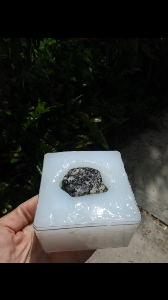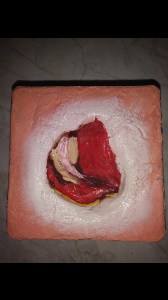HomeGrown Solution: Stage IV Pressure Ulcer
Title
Submitted By
HomeGrown Solution Number
Identification of the Problem
Unique Idea
Objectives
Supplies/Ingredients
- 100% Silicone Caulk, clear
- Spray silicone garage door lubricant
- Dish soap
- Latex craft paint
- Mixing cups and sticks
- Rock, suitable size, depth, texture for desired wound
- Artist paint brushes
- Container to house the wound (video uses bottom of 2 liter soda bottle)
Steps to Creating the Solution
- Fill the container with silicone caulk all the way to the top and scrape off excess with a paint stick. Cover the rock and top of silicone with dish soap. Place rock down into the silicone and allow it to sit for 15 minutes.
- Remove the rock and continue to allow the silicone to sit another 15 minutes. When a thick skin forms down inside the "wound", gently rinse away the soap and allow it to dry.
- Painting: In a small mixing cup, put a few drops of red paint. Squirt a bit of garage door lubricant into the cup and mix. Add a grape size dollop clear silicone and stir. Keep stirring until the texture is smooth. Add additional squirts of garage door lubricant to desired consistency and paint the inner wound. Mix additional colors for slough, bone, and skin. Add colors one at a time, allowing each to dry before adding the next. Work from the deeper areas towards the top. Sponge on the skin color last.
- Seal the entire wound with a mixture of clear silicone and just enough garage door lubricant to thin it down. It will take quite a while for all of the silicone to cure. In the meantime, it will give off acetic acid vapors so store in a well-ventilated place.
Images
Video
HomeGrown Disclaimer
The information contained within this website is for information purposes only. While the website is monitored in an attempt to keep the information up to date and accurate, be aware that there are no representations or warranties of any kind, express or implied, about the completeness, accuracy, reliability, and/or suitability being made. The sponsors of this website are not liable for any loss or damage that may result from using information contained within this website. Any reliance you place on the information contained within this website is strictly at your own risk.
Please note that sections of this website include postings of individuals not associated with the website sponsors. These postings are not endorsed or warrantied by the website, and use of such information is at your own risk.
Always check the user guide/manuals provided by the manufacturer of your manikin or task trainer. Using products that are not sanctioned may invalidate the product warranty. (For example: Some products could stain the skin on a manikin. Liquids used around electrical parts may cause malfunctions.)



